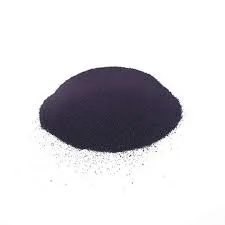Exploring the Benefits and Applications of Sulfur Dyes in Textile Industry
Understanding Sulfur Dyes A Comprehensive Overview
Sulfur dyes have earned their reputation as a highly valued class of dyes used primarily for coloring textiles, particularly cotton and other cellulose fibers. These dyes are recognized for their robust characteristics, including excellent wash fastness and good light resistance, making them incredibly popular in the textile industry. In this article, we will delve into the properties, applications, benefits, and challenges associated with sulfur dyes.
The Composition and Characteristics of Sulfur Dyes
Sulfur dyes are derived from organic compounds that contain sulfur. They are typically produced through a process called sulfonation, which introduces sulfonic acid groups into organic compounds, enhancing their solubility in water. This solubility is crucial, as it allows the dyes to penetrate the fibers of the fabric effectively during the dyeing process.
One of the standout characteristics of sulfur dyes is their ability to bond tightly with cellulose fibers. This strong bond provides durability, which translates into excellent wash fastness. Unlike some other types of dyes, sulfur dyes can withstand repeated washing cycles without significant fading, making them ideal for materials subjected to regular wear and tear.
Applications of Sulfur Dyes
Sulfur dyes are predominantly used in the dyeing of cotton, but their applications extend to various other textiles, including viscose, linen, and certain synthetic fibers. They are particularly favored in the production of denim fabrics, where deep, rich shades are desired.
The versatility of sulfur dyes allows them to produce a wide array of colors. They are commonly available in shades of black, blue, green, and brown, but can also be manipulated to create various other hues. The dyeing process typically involves reducing the sulfur dyes, which converts them into soluble forms that can easily penetrate the fabric fibers. Once the dyeing process is complete, the dye is oxidized back to its original form, which then forms a strong bond with the fibers.
Benefits of Using Sulfur Dyes
1. Cost-Effectiveness Sulfur dyes are often more economical compared to other dye types, making them a preferred choice for large-scale dyeing operations, especially in industries focusing on mass production.
sulfur dyes product

2. Fastness Properties As previously noted, sulfur dyes exhibit exceptional wash fastness, light fastness, and heat fastness. This durability ensures that dyed fabrics maintain their vibrancy even after numerous washes, crucial for consumer satisfaction.
3. Environmental Considerations Though the production of some dyes can have environmental impacts, many modern sulfur dyes have been developed with reduced toxicity and environmental footprint, promoting more sustainable textile production practices.
4. Ease of Use Sulfur dyes can be applied using various methods, including dyeing in batch processes or padding techniques, which provides flexibility in manufacturing processes.
Challenges and Limitations
Despite their numerous advantages, sulfur dyes also come with challenges. One of the primary concerns is their limited color range compared to other dye types like reactive or azo dyes. While they can produce deep and rich shades, achieving lighter colors may be difficult.
Additionally, the dyeing process requires precise control of conditions such as temperature and pH. Failure to maintain optimal conditions can lead to poor color yield or uneven dyeing results. Furthermore, proper disposal of the dyes and minimizing wastewater from the dyeing process is critical to maintaining environmental standards.
Another significant challenge is the potential for allergic reactions in certain individuals. Although rare, some sulfur dyes can cause skin irritation, necessitating careful selection and handling during the dyeing process.
Conclusion
In summary, sulfur dyes are a crucial element in the textile dyeing industry, known for their durability, cost-effectiveness, and ability to produce vibrant colors. They are especially valued in the production of cotton and denim fabrics due to their wash and light fastness. While there are challenges associated with their usage, advancements in technology continue to enhance their application and sustainability. As the industry moves towards environmentally friendly practices, the role of sulfur dyes is likely to evolve, ensuring they remain a staple in textile coloration for years to come.
-
The Timeless Art of Denim Indigo Dye
NewsJul.01,2025
-
The Rise of Sulfur Dyed Denim
NewsJul.01,2025
-
The Rich Revival of the Best Indigo Dye
NewsJul.01,2025
-
The Enduring Strength of Sulphur Black
NewsJul.01,2025
-
The Ancient Art of Chinese Indigo Dye
NewsJul.01,2025
-
Industry Power of Indigo
NewsJul.01,2025
-
Black Sulfur is Leading the Next Wave
NewsJul.01,2025

Sulphur Black
1.Name: sulphur black; Sulfur Black; Sulphur Black 1;
2.Structure formula:
3.Molecule formula: C6H4N2O5
4.CAS No.: 1326-82-5
5.HS code: 32041911
6.Product specification:Appearance:black phosphorus flakes; black liquid

Bromo Indigo; Vat Bromo-Indigo; C.I.Vat Blue 5
1.Name: Bromo indigo; Vat bromo-indigo; C.I.Vat blue 5;
2.Structure formula:
3.Molecule formula: C16H6Br4N2O2
4.CAS No.: 2475-31-2
5.HS code: 3204151000 6.Major usage and instruction: Be mainly used to dye cotton fabrics.

Indigo Blue Vat Blue
1.Name: indigo blue,vat blue 1,
2.Structure formula:
3.Molecule formula: C16H10N2O2
4.. CAS No.: 482-89-3
5.Molecule weight: 262.62
6.HS code: 3204151000
7.Major usage and instruction: Be mainly used to dye cotton fabrics.

